The Canoe Is the People
Indigenous Navigation in the Pacific
Pacific Canoes
After rafts GLOSSARY rafts - floating platforms made from logs tied together , Pacific dugouts GLOSSARY dugouts - canoes made by digging out the centre of a log were some of the first boats in the world... and a technological breakthrough that allowed people to explore the Pacific.
Thousands of years ago, when melting ice flooded South-east Asia and formed tiny islands in a large sea, the Pacific Islanders had to develop better canoes to carry people and link communities. By adding an outrigger GLOSSARY outrigger - side float to the single hull GLOSSARY hull - the body of a boat dugout, they stopped it from rolling over. By adding sails and more wood to the sides of the hull, they made the canoe fast and safe enough to explore the open sea to the east. By making the outrigger the same size as the main hull (a double hull), they made a canoe that could survive storms better and carry more things like crops and animals [See figure 1].
Outriggered vakas GLOSSARY outriggered vakas - canoes made of a single hull and side float were good for fast trips to nearby islands and for chasing tuna. The stronger and more stable double hulls were ideal for settling GLOSSARY settling - moving to occupy new islands. Most sails were triangular. Their shape was good for sailing across and into the wind and for giving a lot of lift to the canoe. Some were quite small - made for safety, not racing. After all, a large sail increases the chance of a canoe capsizing GLOSSARY capsizing - turning over .
By comparison, boats in other parts of the world (for example, Europe, Africa, and China) were mostly used to carry heavy goods like metal and cattle along the coasts. They had to be large and so needed many sails. The more sails they had, the more ballast GLOSSARY ballast - the heavy weight placed low in the hull of European boats to keep them upright they needed to stay upright in the wind [See figure 2]. As a result, they were slow. They didn't need to be as seaworthy GLOSSARY seaworthy - well built, reliable at sea as Pacific canoes because they could stop on land every night.
Surf on the map above to discover the different types of Pacific canoes according to the island they are from.


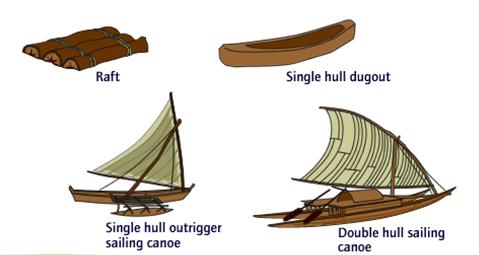



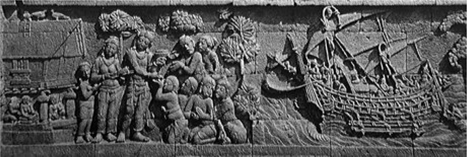
This stone carving (from the Borobudur Buddhist temple in Indonesia) is the oldest known image of a double outrigger (in this case a ship) and dates to about 1200 years ago. It is believed that ships of this type were sailed by Indonesians as far as Madagascar, off the coast of Africa.
This image is from the ArtServe website of the Australian National University.
maintained by Dr Michael Greenhalgh
(image link)

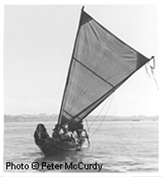
Single-hulled paddling canoe with or without tacking sail
This canoe was used for travel, fishing, and war. Examples are known from the Solomon Islands and Aotearoa (New Zealand).
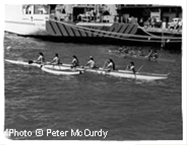
Outrigger paddling canoe with or without tacking sail
Used throughout the Pacific (at different times in history), this type of canoe was used daily for travel and fishing. Examples are known from Vanuatu and Aotearoa (New Zealand).
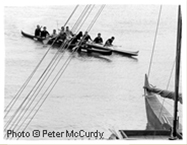
Double-hulled paddling canoe with or without tacking sail
People went to war in this canoe in the eastern Pacific. Examples are known from Tahiti, Aotearoa (New Zealand), and Hawaii.
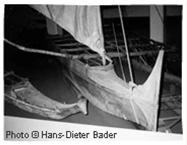
Outrigger sailing canoe with tacking sail
This canoe was used in the central Pacific for travel and fishing. Examples are known from Samoa and Tahiti.
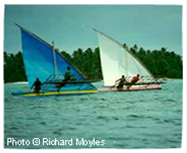
Outrigger sailing canoe with shunting sail
This canoe was used for travel and fishing in the northern and western Pacific. Examples are known from Marshall Islands and Fiji.
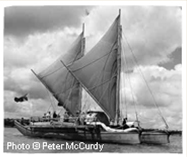
Double-hulled sailing canoe with tacking sail
In the central Pacific, this canoe was used for voyaging. Examples are known from Tonga and Tahiti.
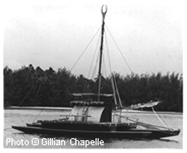
Double-hulled sailing canoe with shunting sail
In the central Pacific, the double-hulled sailing canoe design was later replaced by the massively outrigged (nearly double-hulled) design …which the Tongans used throughout the Pacific. Examples are known from Fiji and the Tuamotu Islands.
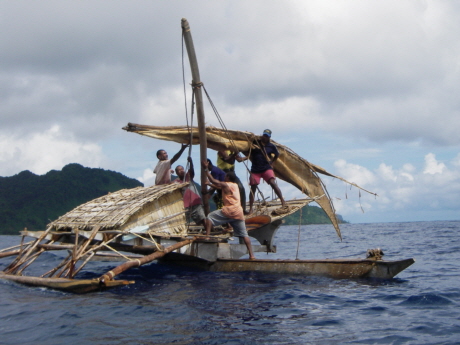
Outrigged shunting sail canoes
Massively outrigged shunting sail canoes are also known to have been used in the Marshall and Caroline Islands, Fiji, and various islands of the SE Solomons…and are still used in Taumako and some Caroline Islands.

Single-hulled paddling canoe with or without tacking sail
This canoe was used for travel, fishing, and war. Examples are known from the Solomon Islands and Aotearoa (New Zealand).

Outrigger paddling canoe with or without tacking sail
Used throughout the Pacific (at different times in history), this type of canoe was used daily for travel and fishing. Examples are known from Vanuatu and Aotearoa (New Zealand).

Double-hulled paddling canoe with or without tacking sail
People went to war in this canoe in the eastern Pacific. Examples are known from Tahiti, Aotearoa (New Zealand), and Hawaii.

Double-hulled paddling canoe with or without tacking sail
People went to war in this canoe in the eastern Pacific. Examples are known from Tahiti, Aotearoa (New Zealand), and Hawaii.

Outrigger sailing canoe with shunting sail
This canoe was used for travel and fishing in the northern and western Pacific. Examples are known from Marshall Islands and Fiji.

Outrigged shunting sail canoes
Massively outrigged shunting sail canoes are also known to have been used in the Marshall and Caroline Islands, Fiji, and various islands of the SE Solomons…and are still used in Taumako and some Caroline Islands.

Single-hulled paddling canoe with or without tacking sail
This canoe was used for travel, fishing, and war. Examples are known from the Solomon Islands and Aotearoa (New Zealand).

Outrigger paddling canoe with or without tacking sail
Used throughout the Pacific (at different times in history), this type of canoe was used daily for travel and fishing. Examples are known from Vanuatu and Aotearoa (New Zealand).

Outrigger sailing canoe with shunting sail
This canoe was used for travel and fishing in the northern and western Pacific. Examples are known from Marshall Islands and Fiji.

Double-hulled sailing canoe with shunting sail
In the central Pacific, the double-hulled sailing canoe design was later replaced by the massively outrigged (nearly double-hulled) design …which the Tongans used throughout the Pacific. Examples are known from Fiji and the Tuamotu Islands.

Outrigged shunting sail canoes
Massively outrigged shunting sail canoes are also known to have been used in the Marshall and Caroline Islands, Fiji, and various islands of the SE Solomons…and are still used in Taumako and some Caroline Islands.

Double-hulled sailing canoe with tacking sail
In the central Pacific, this canoe was used for voyaging. Examples are known from Tonga and Tahiti.

Outrigger sailing canoe with tacking sail
This canoe was used in the central Pacific for travel and fishing. Examples are known from Samoa and Tahiti.

Double-hulled paddling canoe with or without tacking sail
People went to war in this canoe in the eastern Pacific. Examples are known from Tahiti, Aotearoa (New Zealand), and Hawaii.

Outrigger sailing canoe with tacking sail
This canoe was used in the central Pacific for travel and fishing. Examples are known from Samoa and Tahiti.

Double-hulled sailing canoe with tacking sail
In the central Pacific, this canoe was used for voyaging. Examples are known from Tonga and Tahiti.

Double-hulled paddling canoe with or without tacking sail
People went to war in this canoe in the eastern Pacific. Examples are known from Tahiti, Aotearoa (New Zealand), and Hawaii.

Outrigger sailing canoe with tacking sail
This canoe was used in the central Pacific for travel and fishing. Examples are known from Samoa and Tahiti.

Double-hulled sailing canoe with tacking sail
In the central Pacific, this canoe was used for voyaging. Examples are known from Tonga and Tahiti.

Double-hulled sailing canoe with shunting sail
In the central Pacific, the double-hulled sailing canoe design was later replaced by the massively outrigged (nearly double-hulled) design …which the Tongans used throughout the Pacific. Examples are known from Fiji and the Tuamotu Islands.
Click images for more














